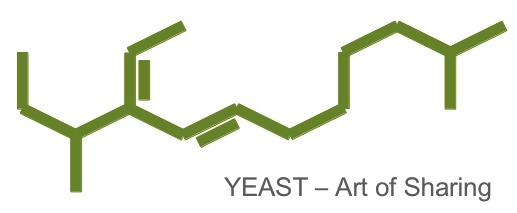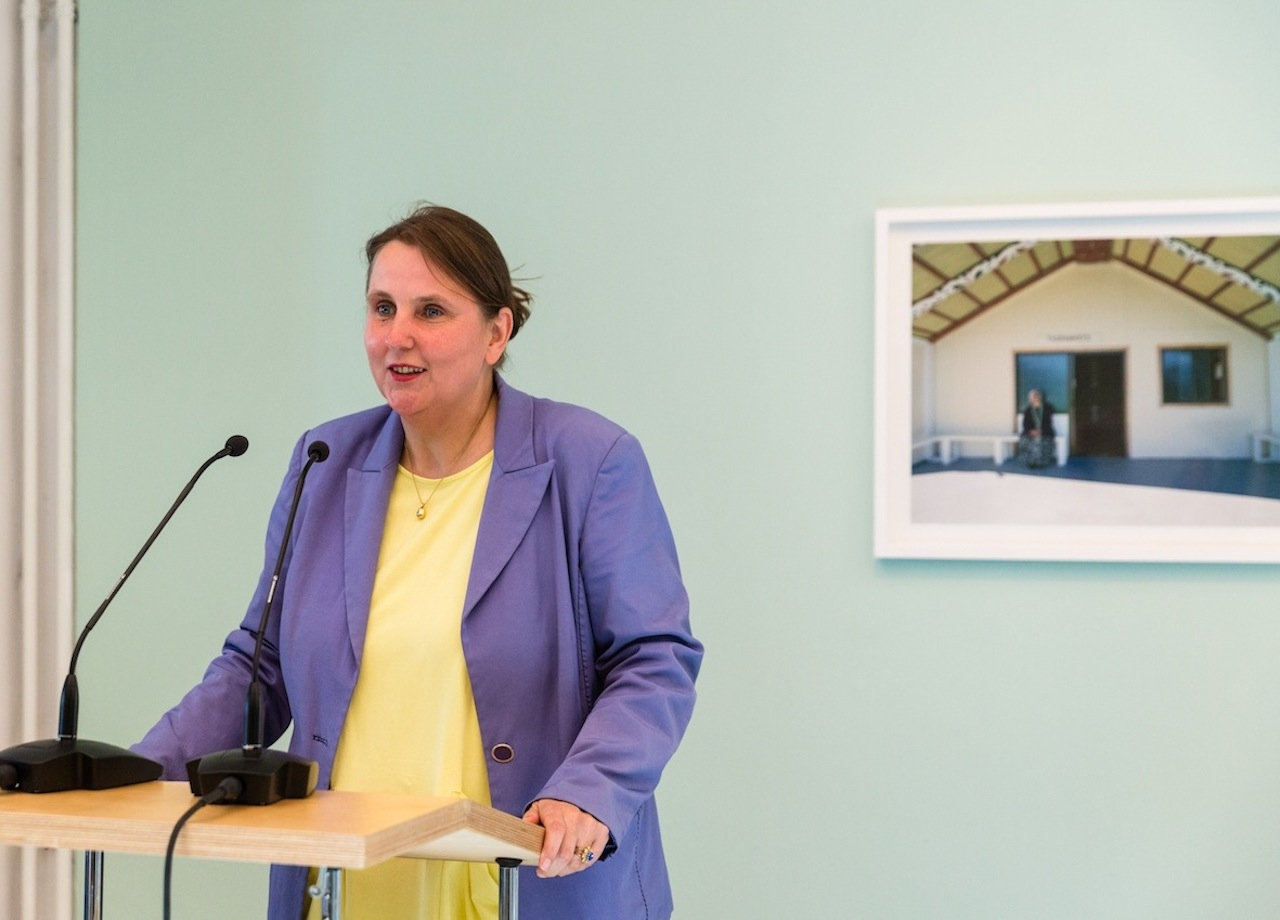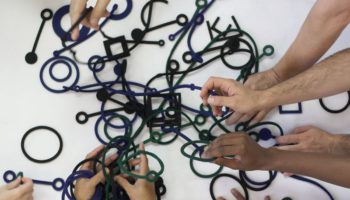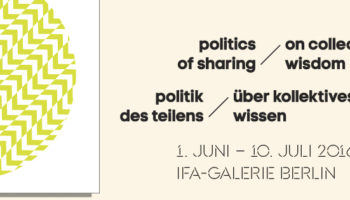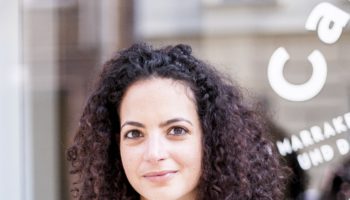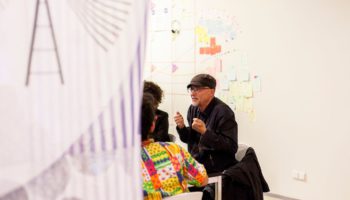Please scroll down for the English version – Frau aus dem Moore, in Ihrer Rolle als Leiterin der Abteilung Kunst des ifa verfolgen Sie ein ganz eigenes kuratorisches Konzept. Wie hat sich das entwickelt? Sie waren ursprünglich ja selbst als Künstlerin tätig.
Institutionen bedeuten einerseits Beständigkeit und erfordern dennoch ein permanentes Um- und Neudenken von Programmen und Formaten. Ich glaube an das Potenzial von Kunst in gesellschaftlichen Transformationen und bin mir sicher, dass Institutionen hier wegweisend sein können. Wir leben in einer Zeit des Wandels und es ist äußerst spannend, diesen mitzugestalten. Institutionen müssen sich öffnen, um Orte des gemeinsamen Denkens, Entwerfens und Handelns zu werden. Die dringlichen Fragen und Erfordernisse in einer Zeit des Wandels habe ich übrigens auch in einem institutionellen Manifest reflektiert.
Eine künstlerische Perspektive einzunehmen kann sehr bereichernd sein. Das künstlerische Arbeiten basiert auf einer Praxis des Nicht-Wissens, was ich als Grundhaltung meiner Arbeit sehe: in immer neue Kontexte zu gehen, möglichst ohne vorgefertigte Meinungen und mit einer Haltung des Nicht-Wissens. Ich habe Kunst- und Literaturwissenschaften studiert und bin nach dem Studium in die künstlerische Richtung gegangen und habe in den Bereichen Fotografie und experimenteller Film gearbeitet.
Mein Interesse gilt der Begegnung, mit und durch die Kunst, mich interessiert die Reflektion über Kunst und deren Potenzial für gesellschaftliche Veränderungen. Mir ist der Kontext, in dem Kunst entsteht, aber auch in dem Kunst gezeigt und diskutiert wird, besonders wichtig. Selbst als Künstlerin hatte ich kaum Interesse daran, meine Kunst alleine auszustellen, sondern habe immer andere dazu eingeladen, eigentlich schon recht früh „kuratiert“. So war es im Grunde ein organischer Fluss, der mich zu dem Beruf der Kuratorin brachte. Das hatte ich als Studentin nicht geplant und wie Sie wissen, gab es in dieser Zeit auch dieses Berufsmodell der Kuratorin noch nicht. Mein erster Job an einer Institution führte mich als Kuratorin an die Shedhalle nach Zürich, wo ich neben Bochum und Osnabrück auch studiert hatte.
Inwiefern war diese Station wichtig für Sie?
Durch die Arbeit an der Schnittstelle von politischen und gesellschaftlichen Fragen, die die Arbeit an der Shedhalle in Zürich ausmachte, und das sehr experimentelle Verständnis von Kuratieren, konnte ich dort die Bedeutung und Wirksamkeit des Informellen und Intimen hervorheben, damals noch Tabubegriffe innerhalb der kritischen Kunstszene. Anschließend kam ich als künstlerische Leiterin an das Künstlerhaus Stuttgart, das ja ebenfalls für ein diskursives Feld des Kuratierens steht. Mein Programm während der vier Jahre dort war sehr international geprägt – was mir letztendlich gute Grundlagen für meine Tätigkeit am ifa gab, wo ich seit 2007 als Leiterin der Abteilung Kunst verantwortlich für die Programme im In- und Ausland bin. Es waren Fragestellungen, die internationale Positionen in den lokalen Kontext rückten.
Zum Beispiel?
 Zum Beispiel war ich Anfang der 2000er Jahre regelmäßig in Brasilien und habe hier in Deutschland eine Ausstellung zur Antropofagia (Entre Pindorama – Zeitgenössische brasilianische Kunst und die Antropofagia, Kunsthaus Stuttgart 2004) gemeinsam mit meinem brasilianischen Freund und Kollegen, Giorgio Ronna, organisiert, eine der ersten Ausstellungen zu diesem Thema in Europa. Um zeitgenössische brasilianische Kunst in Deutschland zu zeigen und verstehen zu können, war es notwendig, den Kontext zu erklären. So kam es dazu, dass wir die künstlerischen Positionen vor dem Hintergrund der Geschichte des Modernismo, des Tropicalismo und der Antropofagia zusammenführten. Es war auch die erste Ausstellung des brasilianischen Künstlers Ricardo Basbaum in Europa, kurze Zeit später war er auf der documenta vertreten.
Zum Beispiel war ich Anfang der 2000er Jahre regelmäßig in Brasilien und habe hier in Deutschland eine Ausstellung zur Antropofagia (Entre Pindorama – Zeitgenössische brasilianische Kunst und die Antropofagia, Kunsthaus Stuttgart 2004) gemeinsam mit meinem brasilianischen Freund und Kollegen, Giorgio Ronna, organisiert, eine der ersten Ausstellungen zu diesem Thema in Europa. Um zeitgenössische brasilianische Kunst in Deutschland zu zeigen und verstehen zu können, war es notwendig, den Kontext zu erklären. So kam es dazu, dass wir die künstlerischen Positionen vor dem Hintergrund der Geschichte des Modernismo, des Tropicalismo und der Antropofagia zusammenführten. Es war auch die erste Ausstellung des brasilianischen Künstlers Ricardo Basbaum in Europa, kurze Zeit später war er auf der documenta vertreten.
Die Ausstellung basiert auf dem Manifesto Antrópofago, das der Schriftsteller Osvaldo de Andrade 1928 verfasst hat. Andrade verfolgt die Devise “Statt das Fremde wegzuschieben, das Fremde fressen”. Im „Modernismo“ wandten er und seine Mitstreiter sich gegen die als zerstörerisch, dominant und rassistisch empfundene europäische Kultur. Der Wissenschaftlichkeit und dem „europäischen Verlangen nach Differenz“ setzte Andrade „das tropische Wuchern, Aneignung, Naivität, Wildheit und Poesie“ entgegen.
Klingt das nicht überraschend aktuell?
Ja, ich habe diesen Ansatz ganz bewusst gewählt, um die Antropofagia als kulturelle Strategie vorzustellen und als Form des gesellschaftlichen Miteinanders vorzuschlagen. Also organisierten wir 2004 ein von der Bundeskulturstiftung gefördertes Symposium zu aktuellen Strategien der Antropofagia im gesellschaftlich-politischen Kontext. Es war ein sehr aufregendes Symposium, das viele Arbeitskontexte hervorbrachte, die heute noch aktuell sind und sowohl akademische Ansätze sowie künstlerische und aktivistische zusammenbrachte. Hier zu erwähnen ist MAIZ, eine aktivistische Migrantinnengruppe aus Österreich, die eine provozierenden Parole ausrief: „Österreicher, wir werden Euch fressen!“.
Das ist nur ein Beispiel, wie ich in Stuttgart bereits am Künstlerhaus Fragen aufgegriffen habe, die bis heute hochaktuell und sehr zentral sind, auch für die Arbeit am Institut für Auslandsbeziehungen, beispielsweise die Auseinandersetzung mit Eduard Glissants Theorie des Archipelischen Denkens. Wichtig ist mir immer die künstlerische Perspektive: wie wird dieses Denken, das gerade das kontinentale Denken ablöst, künstlerisch übersetzt? Das wurde 2005 in der Veranstaltungsreihe Inselungen, im Künstlerhaus Stuttgart, untersucht.
Die zentrale Frage einer kuratorischen Praxis des kontextualen Arbeitens lautet: „Aus welchem Grund zeige ich gerade diese internationalen Künstlerinnen und Künstler hier in Deutschland? Welche Diskussionen sind damit zu eröffnen?“ Wichtig ist, die verschiedenen Perspektiven zu zeigen und damit dem lokalen Kontext etwas hinzuzufügen, bzw. Veränderungen zu ermöglichen.
Welche Diskussionen wollen Sie denn öffnen?
Mir geht es um Anregungen für gesellschaftliche Transformation. Würde man den nächsten Schritt denken, wäre dieser eine Implementierung künstlerischer Praktiken und Inhalte in gesellschaftliche Prozesse. Ich wünsche mir Strukturen, in denen Künstlerinnen und Künstler in den Entscheidungsgremien sitzen, in denen die kostbaren Erkenntnisse künstlerischer Forschung in gesellschaftliche und politische Entscheidungsprozesse einfließen können.
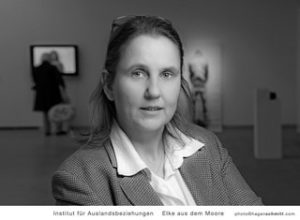
An diesem Punkt sind wir aber noch nicht. Bisher fungieren Ausstellungen als Anstöße zur Veränderung. Und das ist auch gut, denn sehr schnell wären wir wieder bei der Funktionalisierung von Kunst. Dennoch wäre der nächste Schritt zur Wirkung von Kunst auf gesellschaftsverändernde Prozesse denkbar, allerdings in einem vollkommen neu zu strukturierendem System von Kunstinstitutionen und Kunstausstellungen. Dies setzt einen Weg der Öffnung voraus, den die meisten Institutionen derzeit noch nicht bereit sind zu gehen.
Aus Brasilien kommen hier interessante Impulse, z.B. Marcelo Rezende, der ehemalige Direktor des Museums in Salvador de Bahia, der mit Besucherinnen und Besuchern, Angestellten des Museums und Vertretern des Staates gemeinsam über Hierarchien sprach und dazu aufforderte, an den öffentlich stattfindenden Programmplanungen teilzunehmen.
Die Weiterentwicklung auf der institutionell-kuratorischen Praxis bedeutet, gesellschaftliche Implementierungen zu begleiten, die aus der Kunst heraus entstehen, und die Prozesse von Beginn an gemeinsam zu erarbeiten, umzusetzen und auszuwerten. Diese Praxis ist sicherlich sehr zeitintensiv aber wesentlich „effektiver“. Kollaboration erfordert ein sich aufeinander einlassen, eine Art „radikalen Respekt“ (nach David Bohm), der aktiver ist als Empathie, eine Praxis, die es ermöglicht, jede einzelne Perspektive anzunehmen.
Welche Rolle spielen die Kunstvermittlungsprogramme?
Im Gegensatz zu großen Häusern setzen wir auf intime Momente, auf inhaltlich anspruchsvolle Gespräche, die versuchen, jede Stimme einzubeziehen. Durch Kunstvermittlungsprogramme etwa, die den Ansatz haben, das Publikum mit seiner eigenen Perspektive ernst zu nehmen, durch Projekte, die die Besucherinnen und Besucher als Akteurinnen und Akteure verstehen.
Mit diesem Zugang ist unser Kunstvermittlungsteam mit seinen Angeboten sehr weit und radikal. Es ist ein einfaches und dennoch sehr wirksames Erfolgskonzept, das den von mir initiierten Projekten inne ist. Sie basieren auf dem Prinzip der Akteur-Netzwerk-Theorie Bruno Latours, d. h., der aktiven Beteiligung und des Aktivseins innerhalb eines Projektes. Wir wollen unseren Raum als Bühne für jeden öffnen und suchen vielmehr Akteure als Teilnehmer.
Haben Sie dafür schon eine Idee oder ein konkretes Projekt? Politics of Sharing und Radio KUNCI waren hierfür ja bereits ein wegweisender Ansatz.
Ja, in der Tat war der Open Space mit dem indonesischen Kollektiv KUNCI in der ifa-Galerie im Rahmen des Projektes Politics of Sharing sehr wegweisend, da hier der institutionelle Raum

komplett geöffnet wurde. Allerdings stehen wir hier erst am Anfang. Mir geht es darum, dass die Diskurse oder die Fragestellungen, die wir mit den Ausstellungen eröffnen, reich sind und einen großen Wert für gesellschaftliche Prozesse haben, die dann in Gang kommen. Da besteht insgesamt sehr viel Potenzial.
Paulo Herkenhoff, der brasilianische Kurator und Kunstkritiker, hat anlässlich der Eröffnung des Museu de Arte do Rio (MAR) postuliert, das Museum muss sich fressen lassen. Das meint, dass die Museen sich öffnen müssen, denn die Schwelle der institutionellen Türen ist unglaublich hoch und schwer zu überschreiten. Wie kann man diese Schwelle senken und wie öffnet man den Raum?
Radio KUNCI, mit dem sich die Berliner ifa-Galerie in die temporäre Radiostation eines indonesischen Künstler- und Intellektuellenkollektivs verwandelte, war hier zum Beispiel genau der Weg, um das möglich zu machen. Mir war es wichtig, in einem Projekt zum Teilen, auch über das Teilen der Institution nachzudenken. Und so war es eine folgerichtige Entscheidung, den institutionellen Raum zur Verfügung zu stellen und dem Künstlerkollektiv den Raum zu überlassen. Daraus entstanden ganz neue Verzweigungen und Ansätze. So wurde beispielsweise der indonesische Begriff Numpang vorgestellt, um andere Formen des Miteinanderlebens aufzuzeigen. Hierbei geht es um ein gesellschaftliches Konzept, des sich gegenseitig Stützens und Unterstützens, außerhalb kommerzieller Wertesysteme. Gleichzeitig wurden zahlreiche Initiativen mit in Deutschland neu ankommenden Kulturschaffenden eingeladen, um mit uns zu diskutieren und Möglichkeiten und Potentiale auszuloten.
Kann aus der Idee Realität werden?
Ja, beispielsweise hat sich ein loser Kreis von Institutionen wie dem ifa, dem Goethe-Institut, dem DAAD, den Kunstwerken, der Kunsthochschule Weißensee etc., aber auch Kulturschaffenden und KünstlerInnen, gebildet, der sich „FLAX“ nennt. Die Initiative ging von den KünstlerInnen in unseren Beiräten aus. Sie betonten die Notwendigkeit, etwas für die Situation von Kunstschaffenden, die hier neu ankommen, die geflüchtet sind, zu tun. Die Initiative FLAX gibt es erst seit ein paar Monaten, es wurde bereits eine Datenbank aufgestellt mit Kunstschaffenden, die aus Syrien und anderen Ländern kommen. Das ist eine wirkungsvolle Form, eine institutionelle Infrastruktur zu teilen, um miteinander neue Angebote und Strukturen zu schaffen.
Unterstützt von der Bundesregierung in Form des Auswärtigen Amtes, fördert das ifa solche Strukturänderungen. Ist das einmalig in Europa?
Das ifa arbeitet besonders stark in Netzwerken und in haptischen Formen. Das heißt, durch Ausstellungen Erfahrungen zu vermitteln und Dialoge zu eröffnen, hat eine zentrale Bedeutung in unserer Arbeit. Netzwerke, die uns wichtig sind, sind die vom ifa mitgegründete IBA (International Biennial Association) oder das lose Netzwerk der VAP (Visual Arts Platform), das einige der europäischen Mittler-Institutionen für die auswärtige Kulturpolitik miteinander verbindet, etwa die Danish Art Agency, Pro Helvetia, das BAM, die Mondrian-Stiftung, das norwegische OCA – Office for Contemporary Art oder das Arts Council Großbritannien.
Die gegenwärtige Auswärtige Kulturpolitik in Deutschland ist sich sehr wohl darüber im Klaren, dass neben organisierten Strukturen des kulturellen Austausches die informellen Austauschprinzipien gerade von KünstlerInnen unglaublich wichtig sind, und das ist natürlich besonders schön und bestärkend für unsere Arbeit. Schließlich vertritt und unterstützt das ifa mit seinen Förderprogrammen sowie regelmäßig stattfindenden Konferenzen und Veranstaltungen die freie Kunstszene Deutschlands und deren Aktivitäten im Ausland. In der Auswärtigen Kulturpolitik hat sich die Auffassung von der Kultur als dritte Säule aufgelöst. Kultur wird heute als starkes Fundament betrachtet, das sich durch alle Bereiche zieht. Die Auswärtige Kulturpolitik erkennt die Kultur als eigenständiges Instrument an, wobei sie nicht nur als Instrumentarium gesehen wird. Die Politik hat erkannt, dass Kultur diesen absoluten Freiraum braucht, um Potenziale freizusetzen.
Inwiefern reagieren Sie flexibel auf globale Entwicklungen?
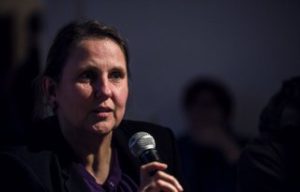
Wir als Förderinstitution – das ifa fördert ja auch insbesondere Biennalen, die dann KünstlerInnen aus deutschen Kontexten einladen – erleben gerade, dass sich das weltliche Gefüge und der Diskurs immens verändern. Es gibt mittlerweile viele Biennalen, die ausschließlich KünstlerInnen des Globalen Südens einladen, z.B. kreist das Thema der Yogyakarta Biennale um die Kunstszenen rund um den Äquator. Das ist eine Entwicklung, die sich aus der jahrzehntelangen Dominanz des Westens ableiten lässt und die sehr ausgrenzend gewirkt hat.
Diese neue Schwerpunktverschiebung kann sehr erfrischend wirken – Ausgrenzung mal anders rum. Wichtig ist es aber, gemeinsame Diskurse zu führen. So richtet das ifa regelmäßig Konferenzen aus, die das Format Biennale kritisch reflektieren. Hier kommen unterschiedliche Stimmen aus aller Welt zusammen, z.B. auch die Direktorin der Yogyakarta Biennale.
Für ein Kulturinstitut ist es wichtig, als Impulsgeber zu agieren und die brisanten Fragen zu stellen und gemeinsam zu diskutieren, die notwendig sind, um eine neue Weltkulturgemeinschaft zu ermöglichen. Diese sollte auf unterschiedlichen Perspektiven aufgebaut sein, lokale Bedingungen akzeptieren, respektieren und sie in den internationalen Kontext als Bereicherung aufnehmen.
Zieht sich das nicht wie ein roter Faden durch die von Ihnen initiierten Projekte?
Ja, in der Tat. In den ersten Jahren beim ifa hatte ich bereits die Plattform Prêt-à-Partager zu Kunst, Stadt und Mode konzipiert, aus der sich eine wandernde Ausstellung entwickelt hat, die sehr erfolgreich in sieben afrikanischen Städten gezeigt wurde. Hierzu fanden immer wieder Workshops statt mit afrikanischen und europäischen Künstlerinnen und Künstlern zur Verschränkung von urbanem Leben, Moden, Styles und Performances. Dieses Projekt, ein Leuchtturm der Aktion Afrika des Auswärtigen Amtes, war ein ausgesprochen erfolgreiches Projekt, das viele Beziehungen hervorgebracht hat. In der Auseinandersetzung mit den verschiedenen Kulturszenen Afrikas wurde mir bewusst, dass eine digitale Vernetzung fehlt, und daraus entstand die Idee für das Online-Magazin Contemporary And (C&), das ich dann gemeinsam mit Yvette Mutumba und Julia Grosse auf den Weg gebracht habe. Denn die Informationen zu zeitgenössischen KünstlerInnen, KuratorInnen, Artspaces oder Initiativen auf dem afrikanischen Kontinent und der Diaspora waren kaum zugänglich in dieser Zeit um 2008/09.
Die Entwicklung des Magazins zeigt auf, wie im Rahmen eines Projektes mit dem Auftrag der Aktion Afrika, die kulturellen Beziehungen zwischen Deutschland und Afrika zu verstetigen, eine große Wirkung erzielt wurde. Ich konnte diese Erfahrungen als Impulse weitergeben, in der Entwicklung von TURN, einem speziellen Fonds der Bundeskulturstiftung (KSB), der die Förderung für Projekte mit afrikanischem Bezug vorsieht. Deutschland hat in der Aufarbeitung seiner Kolonialgeschichte noch eine Menge zu leisten. Solange diese Aufarbeitung nicht stattgefunden hat, können sich keine „normalen“ kulturellen Beziehungen entwickeln und dafür sind gesonderte Maßnahmen erforderlich. Langsam ändert sich das, ausschlaggebend für diese Veränderungen sind sicherlich auch die Aktion Afrika des Auswärtigen Amtes und der Fonds TURN der KSB. Der nächste Schritt liegt nun in der Dekolonisierung der Institutionen, d.h. in der Bewusstmachung von Machtstrukturen und deren Aufhebung.
Und werden Sie diesem Thema eine besondere Beachtung zukommen lassen?
Im kommenden Jahr werden wir uns in der ifa-Galerie Berlin ein ganzes Jahr lang dem Thema Kolonialität widmen. Mit dem Ansatz, nicht ausschließlich im Historischen oder in der Vergangenheit herumzustochern, sondern stattdessen den gesamten Komplex viel breiter zu fassen. Das Verständnis und die Strukturen der Institutionen sind von sichtbaren, aber auch von unsichtbaren Machtkonstellationen geprägt, die es gilt sichtbar zu machen und zu dekonstruieren. Eine wichtige Voraussetzung dafür ist es, sich mit den „Wunden des Kolonialismus“ auseinander zu setzen. Nur so schaffen wir die Voraussetzung für eine neue Weltkulturgemeinschaft.
–––––––––––––––––––––––––––––
— ENGLISH VERSION —
Interview with Elke aus dem Moore, Director of the Fine Arts Department at ifa – Institut für Auslandsbeziehungen.
Interviewed on 29 August 2016 by Constanze Musterer and Inge Pett.
Institution in Transition – On the Significance of Institutional Openness and Active Participation
Frau aus dem Moore, in your role as Director of the ifa Fine Arts Department you have your own specific curatorial approach. How has this developed? You began your own career as a curator.
On the one hand institutions represent continuity, and yet their programmes and formats also need to be continually rethought and redesigned. I believe in the potential of art in processes of social transformation and I am sure that institutions can show the way. We are living in a time of change and it is truly fascinating to be able to shape change. Institutions must open up, becoming places where people think, create and act together. I have written an institutional manifesto reflecting on the urgent questions and needs in a time of change.
Taking an artistic perspective can often be very enriching. Artistic work is based on a practice of not knowing, which is the basic premise of my own work – always entering new contexts, preferably without preconceived opinions and in an attitude of not knowing. I studied art history and literature and after finishing my studies I first worked as an artist, and then I worked in photography and experimental film.
My interest is in encounters, with and by means of art. I am interested in reflecting on art and its potential to bring about social change. I am especially concerned with the contexts in which art is made, and also where it is shown and talked about. When I was working as an artist myself I was never really interested in exhibiting my work alone. I always invited others to join in – I was already working as a curator in a way. Moving to curating professionally was like an organic process for me. I had not planned to do this when I was a student, and – as you know – back then there was no “profession” of curator. My first job in an organisation was as a curator at the Shedhalle in Zurich, where I had spent part of my time as a student – alongside Bochum and Osnabrück.
What made this stage in your career important for you?
Work at the Shedhalle in Zurich was always at the interface with political and social issues, while curating was understood very experimentally there. I was able to emphasise the significance and effect of the informal and the intimate, which were taboo concepts in the art scene at the time.
Then I moved to become artistic director at Künstlerhaus Stuttgart, which also stands for a discursive approach to curating. My programme over four years there was very international, which then became a good basis for my work at ifa, where I have been heading the Fine Arts Department since 2007 and am responsible for programmes in Germany and abroad. These were questions that brought international perspectives into local contexts.
For example?
For example, after 2000 I went regularly to Brazil and organised an exhibition on Antropofagia (Entre Pindorama – Contemporary Brazilian Art and Antropofagia at Künstlerhaus Stuttgart 2004) together with my Brazilian friend and colleague Giorgio Ronna. It was one of the very first exhibitions on this theme in Europe. To show and understand contemporary Brazilian art in Germany, we had to explain the context. This meant that we presented artistic positions against the backdrop of the history of Modernismo, Tropicalismo and Antropofagia. This was also the first exhibition showing Brazilian artist Ricardo Basbaum in Europe, and a short while later he was included in documenta.
The exhibition was based on the Manifesto Antrópofago, written in 1928 by the author Osvaldo de Andrade. His motto was: “Instead of pushing the foreign away, eat it.” In Modernismo, he and his fellow artists turned against European culture, which they perceived as being destructive, dominant and racist. Andrade counters academia and the “European desire for difference” with “tropical proliferation, appropriation, naivety, wildness and poetry”.
Doesn’t that sound remarkably topical?
Yes. I deliberately chose to present Antropofagia as a cultural strategy and a form of social coexistence. In 2004 we organized a symposium supported by the German Federal Cultural Foundation on contemporary strategies of Antropofagia in social and political contexts. This was a very exciting conference that led to a large number of working constellations that are still relevant today, including linking scholarly work, artistic work and activism. One example is MAIZ, an activist migrant group in Austria, with their provocative slogan: “Austrians, we will eat you!”
This is just one example of how I was able to raise questions during those years at the Stuttgart Künstlerhaus, questions that I still see as highly relevant and important today, also for my work at the Institut für Auslandsbeziehungen – for example exploring Eduard Glissant’s theory of archipelagic thinking. I am always interested in the artistic perspectives: how is this way of thinking, which is replacing continental thinking, translated into art? This was explored in 2005 in a programme of events at Künstlerhaus Stuttgart entitled Inselungen – or Islets in English.
The central question in a curatorial practice of contextual work is: “Why am I showing these international artists here in Germany? What discussions should this initiate?” It is important to show various perspectives and to thereby add something to the local context and to facilitate change.
Which discussions do you want to initiate?
I am interested in ideas for social transformation. Thinking about the next step, then this would be to implement artistic practices and contents into social processes. I would like to see structures in which artists are involved in decision-making bodies, in which the valuable insights of artistic research can enter into social and political decision-making processes.
But we are not there yet. So far exhibitions can be just catalysts of change. And that is good, because we need to beware of functionalising art. But the next step would still be that art influences processes of social change, but within a completely new structure in the system of art institutions and art exhibitions. This requires a new form of opening up that most institutions today are not ready to embrace. There are interesting impulses from Brazil, such as Marcelo Rezende, former director of the museum in Salvador de Bahia, who spoke with museum visitors, staff and representatives of the state about hierarchies and asked them to participate in public planning meetings for the museum’s programme.
To further develop institutional curatorial practice means accompanying social implementations that derive from art and jointly designing these processes from the outset, then putting them into place and evaluating them. This would certainly require lots of time, but it would be much more “effective”. Collaboration means accepting each other, in a kind of “radical respect” (as the sense of David Bohm), which is more active than empathy – a practice that makes it possible to take in every single perspective.
What is the role of art education programmes?
Unlike the large museums, we wish to work with intimate moments, conversations that take contents seriously and try to include every voice. We do this with art education programmes that are aimed to take the public and their views seriously, and with projects that see visitors as protagonists. This approach makes what our art education team offers very broad and radical. It is a simple and yet very effective recipe for success that the projects I initiate are based on – the principle of Bruno Latour’s actor-network theory – active participation and active being during a project. We want to open up our spaces as stages for everyone, and we are more looking for protagonists than participants.
Do you already have an idea or a concrete project for doing this? Politics of Sharing and Radio KUNCI were already pioneering in this respect.
Yes, the Open Space with the Indonesian collective KUNCI in the ifa Gallery as part of the Politics of Sharing project was very forward-looking, as here the institutional space was completely opened up.
But this is just the beginning. I want the discourses and questions that we initiate with our exhibitions to be rich and to have real value for social processes that are set in motion. There is a lot of potential here.
At the same time numerous initiatives with people working in culture who have recently arrived in Germany were invited to join in the conversation with us and to explore opportunities and potential.
Can the idea become reality?
Yes. A loose group of institutions such as ifa, the Goethe-Institut, the DAAD, Kunstwerke, Weissensee Art Academy in Berlin and others, and a number of artists and people working in the field of culture have all come together in an initiative called FLAX. The idea came from the artists in our advisory boards, who emphasised the need to do something for artists and people with cultural professions who are arriving here, as refugees. FLAX has been going only a few months now and it has already set up a database with lists of artists from Syria and other countries. This is an effective way of sharing institutional infrastructures and creating new offers and structures together.
With the support of the German government in the shape of the Foreign Office, ifa promotes this kind of structural change. Is this unique in Europe?
ifa works particularly strongly in networks and in haptic ways. The fact that our exhibitions present experiences and initiate dialogue is key to our work. Networks that are important to us include the International Biennial Association (IBA), which we co-founded, and the loose network VAP, Visual Arts Platforms, which brings together a number of Europe’s institutions disseminating foreign cultural policy, such as the Danish Art Agency, Pro Helvetia, BAM, the Mondriaan Foundation, the Norwegian OCA – Office for Contemporary Art and the British Arts Council.
Today, foreign cultural policy in Germany is well aware that alongside organised structures of cultural exchange it is the informal structures that are really important, especially for artists. This awareness is really good and supportive for our work, as ifa’s support ensures that its programmes and regular conferences and events represent and promote the freelance art scene in Germany and its activities abroad.
In foreign cultural policy, the idea that culture is a “third pillar” has been dropped. It is seen today as a strong foundation relevant to all fields. Foreign cultural policy recognizes culture as an independent instrument, without seeing it as a mere tool. Politics has understood that culture requires complete freedom to be able to free up potential.
How do you react flexibly to global developments?
ifa supports events, in particular biennials that invite artists from German contexts, and right now we are experiencing massive change in global systems and discourse. There are now many biennials that invite only artists from the global south. The Yogyakarta Biennale focuses on art scenes around the equator, for example. This is a development that can be seen to derive from the decades of Western dominance that had highly exclusive effects. New focuses can be very refreshing – exclusion with the tables turned. But it is important to enter into shared discourses. This is why ifa regularly organises conferences that reflect critically on the format of the biennial, where diverse voices from all over the world come together, including for example the director of the Yogyakarta Biennale. It is important that an art institute acts to provide impulses, asks provocative questions, and enters into the shared discussion that is necessary to facilitate a new global cultural community based on different perspectives and accepting and respecting local conditions and bringing them as enrichment into the international context.
Is that not a kind of common theme in all the projects you have initiated?
Yes, it is. In my first years at ifa I developed the platform Prêt-à-Partager on art, the city and fashion, which led to a touring exhibition that was shown to great success in seven African cities. This was accompanied by workshops with African and European artists on the interweaving of urban life, fashion, style and performance. This project, a lighthouse project of the German Foreign Ministry’s Action Africa programme, was highly successful and led to a large number of new working relationships. When exploring various cultural scenes in Africa I realised that digital networking was lacking, and this led to the idea for the online magazine Contemporary And (C&), which I established together with Yvette Mutumba and Julia Grosse. At the time, in 2008 and 2009, there was very little available information on contemporary artists, curators, art spaces and initiatives in Africa and the diaspora.
The development of this magazine shows that we have achieved a lot within a project following the Action Africa remit, and have managed to create sustained cultural relations between Germany and Africa. I was able to pass our experience in this onto others, by way of ideas to develop TURN, a special Federal Cultural Foundation fund for projects with reference to Africa. Germany still has a lot to do in terms of critically reflecting on its own colonial history, and as long as this work has not taken place we cannot develop “normal” cultural relations. This requires special measures. Things are slowly changing, and the Foreign Ministry’s Action Africa and the Cultural Foundation TURN fund are key elements in this. The next step must be the decolonization of the institutions, in making structures of power known and in changing them.
Will you give this theme special attention?
Next year, ifa Gallery Berlin will devote the whole year to the theme of coloniality. The intention is not just to probe into history and the past but to see the whole issue much more broadly. The understanding and structures of institutions are shaped by visible and invisible constellations of power that we want to make visible and to deconstruct. One important precondition for this is to look critically at the “wounds of colonialism”. Only then can we create what is needed for a new global cultural community.
